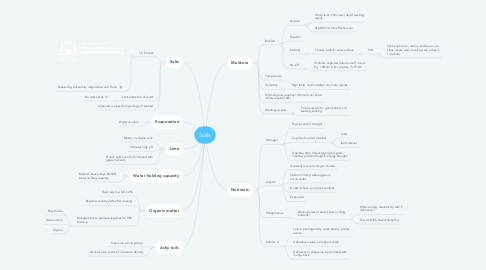
1. Salts
1.1. 1:5 EC test
1.1.1. Measuring soil salinity | Agriculture and Food
1.2. Limit extraction of water
1.2.1. Na worse than Cl
1.3. Captured in clays from geology of seabed
2. Evaporation
2.1. Highly variable
3. Lime
3.1. Mostly in alkaline soils
3.2. Indicates high pH
3.3. 'Good' soils have CaCo3 found with gypsum sheets
4. Water holding capacity
4.1. Medium-heavy clays (40-50% water holding capacity
5. Organic matter
5.1. Relatively low 0.8-1.2%
5.2. Brigalow country 2-3% after clearing
5.3. Management to promote legumes for OM build up
5.3.1. Rhynchosia
5.3.2. Desmodium
5.3.3. Glycine
6. Ashy soils
6.1. Take more rain to wet up
6.2. General rule= reduce 1/3 tussock density
7. Moisture
7.1. Rainfall
7.1.1. Amount
7.1.1.1. 10mm rain= 25mm soil depth (wicking rapid)
7.1.1.2. 4kg DM/ha/mm effective rain
7.1.2. Duration
7.1.3. Intensity
7.1.3.1. 1 heavy rainfall= seals surface
7.1.3.1.1. OR
7.1.4. Run-off
7.1.4.1. 13-65mm captured before runoff occurs. E.g. 100mm in hr= capture 13-15mm
7.2. Temperature
7.3. Humidity
7.3.1. High temp, low humidity= dry more rapidly
7.4. Mitchell grass requires 14% minimum (most others require 16%)
7.5. Wetting up soils
7.5.1. Follow up rain for germination, soil wetting, wicking
8. Nutrients
8.1. Nitrogen
8.1.1. High at end of drought
8.1.2. Captured in plant material
8.1.2.1. roots
8.1.2.2. leaf material
8.1.3. Depletes after 3-4 average/good years, creating 'protein drought'/'energy drought'
8.2. Sulphur
8.2.1. Generally low according to studies
8.2.2. Seldom limiting where gypsum accumulates
8.2.3. Doesn't show up in plant samples
8.2.4. Expensive
8.3. Phosphorous
8.3.1. Generally low at end of season (Aug onwards)
8.3.1.1. When calving- relationship with P deficiency?
8.3.1.2. Test via NIRS Faecal Sampling
8.4. Vitamin A
8.4.1. Low in prolonged dry, open downs, prickly acacia
8.4.2. Deficiency issues in pregnant cattle
8.4.3. Deficiency in sheep can be confused with humpy back

